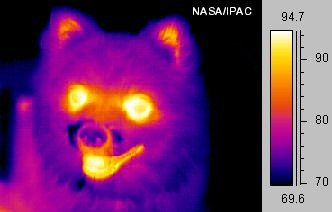Infrared
|
|
Infrared (IR) radiation is electromagnetic radiation of a wavelength longer than visible light, but shorter than microwave radiation. The name means "below red" (from the Latin infra, "below"), red being the color of visible light of longest wavelength. Infrared radiation spans three orders of magnitude and has wavelengths between 700 nm and 1 mm.
| Contents |
Different regions in the infrared
IR is often subdivided into:
- near infrared NIR, IR-A DIN, 0.7–1.4 µm in wavelength, defined by the water absorption, and commonly used in fiber optic telecommunication because of low attenuation losses in the SiO2 glass (silica) medium.
- short wavelength IR SWIR, IR-B DIN, 1.4–3 µm, water absorption increases significantly at 1450 nm
- mid wavelength IR MWIR, IR-C DIN, also intermediate-IR (IIR), 3–8 µm
- long wavelength IR LWIR, IR-C DIN, 8–15 µm)
- far infrared FIR, 15–1000 µm
However, these terms are not precise, and are used differently in various studies i.e. near (0.7–5 µm) / mid (5–30 µm) / long (30–1000 µm). Especially at the telecom-wavelengths the spectrum is further subdivided into individual bands, due to limitations of detectors, amplifiers and sources. Infrared radiation is often linked to heat, since objects at room temperature or above will emit radiation mostly concentrated in the mid-infrared band (see black body).
Atmospheric_transmittance_infrared.gif
The common nomenclature is justified by the different human response to this radiation (near infrared = the red you just cannot see, far IR = thermal radiation), other definitions follow different physical mechanisms (emission peaks, vs. bands, water absorption) and the newest follow technical reasons (The common silicon detectors are sensitive to about 1050 nm, while InGaAs sensitivity starts around 950 nm and ends between 1700 and 2200 nm, depending on the specific configuration). Unfortunately the international standards for these specifications are not currently available.
Telecommunication bands in the infrared
Optical telecommunication in the near infrared is technically often separated to different frequency bands because of availability of light sources, transmitting /absorbing materials (fibers) and detectors.
- O-band 1260–1360 nm
- E-band 1360–1460 nm
- S-band 1460–1530 nm
- C-band 1530–1565 nm
- L-band 1565–1625 nm
- U-band 1625–1675 nm
The Earth as an infrared emitter
The Earth's surface absorbs visible radiation from the sun and re-emits much of the energy as infrared back to the atmosphere. Certain gases in the atmosphere, chiefly water vapor, absorb this infrared, and re-radiate it in all directions including back to Earth. Thus, the greenhouse effect, keeps the atmosphere and surface much warmer than if the infrared absorbers were absent from the atmosphere.
Applications
Night Vision
Infrared is used in night-vision equipment, when there is insufficient visible light to see an object. The radiation is detected and turned into an image on a screen, hotter objects showing up brighter, enabling the police and military to acquire thermally significant targets, such as human beings and automobiles.
Smoke is more transparent to infrared than to visible light, so fire fighters use infrared imaging equipment when working in smoke-filled areas because it does not interfere with other devices in adjoining rooms - this is especially important in areas of high population density (IR does not penetrate walls).
Other Imaging
In infrared photography, infrared filters are used to capture only the infrared spectrum. Digital cameras often use infrared blockers. Cheaper digital cameras and some camera phones which do not have appropriate filters can "see" infrared, appearing as a bright white colour (try pointing a TV remote at your digital camera). This is especially pronounced when taking pictures of subjects near bright areas (such as near a lamp), where the resulting infrared interference can wash out the image.
Thermography
Infrared radiation can be used to remotely determine the temperature of objects (if the emissivity is known). This is termed thermography, or in the case of very hot objects in the NIR or visible it is termed pyrometry. Thermography (thermal imaging) is mainly used in military and industrial applications but the technology is reaching the public market in the form of infrared cameras on cars due to the massively reduced production costs.
Heating
Infrared radiation is used in Infrared saunas to heat the sauna's occupants and to remove ice from the wings of aircraft (de-icing).
Communications
IR data transmission is also employed in short-range communication among computer peripherals and personal digital assistants. These devices usually conform to standards published by IrDA, the Infrared Data Association. Remote controls and IrDA devices use infrared light-emitting diodes (LEDs) to emit infrared radiation which is focused by a plastic lens into a narrow beam. The beam is modulated, i.e. switched on and off, to encode the data. The receiver uses a silicon photodiode to convert the infrared radiation to an electric current. It responds only to the rapidly pulsing signal created by the transmitter, and filters out slowly changing infrared radiation from ambient light.
Spectroscopy
Infrared radiation spectroscopy is the study of the composition of (usually) organic compounds, finding out a compound's structure and composition based on the percent transmittance of IR radiation through a sample. Different frequencies are absorbed by different stretches and bends in the molecular bonds occurring inside the sample. Carbon dioxide, for example, has an absorption band at 4.2µm.
History
The discovery of infrared radiation is commonly ascribed to William Herschel, the astronomer in the early 19th century. Herschel used a prism to refract light from a hot source and detected the infrared, beyond the red part of the spectrum, through an increase in the temperature recorded on a thermometer.
See Also
| Electromagnetic Spectrum
Radio waves | Microwave | Terahertz radiation | Infrared | Optical spectrum | Ultraviolet | X-ray | Gamma ray Visible: Red | Orange | Yellow | Green | Blue | Indigo | Violet |
ca:Infraroig cs:Tepelné záření da:Infrarød stråling de:Infrarotstrahlung et:Infrapunakiirgus Infrared es:Radiación infrarroja fr:Infrarouge it:Radiazione infrarossa he:תת אדום nl:Infrarood ja:赤外線 no:Infrarød stråling pl:Podczerwień pt:Radiação infravermelha ru:Инфракрасное излучение sl:infrardeče sevanje fi:Infrapunasäteily zh:红外线

